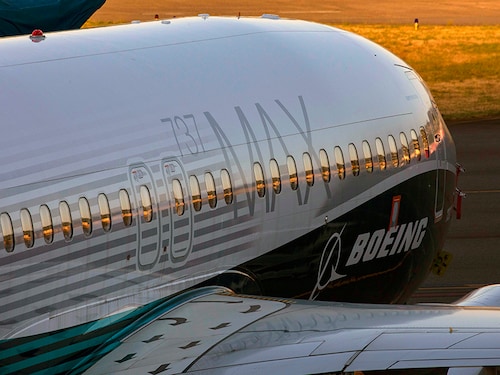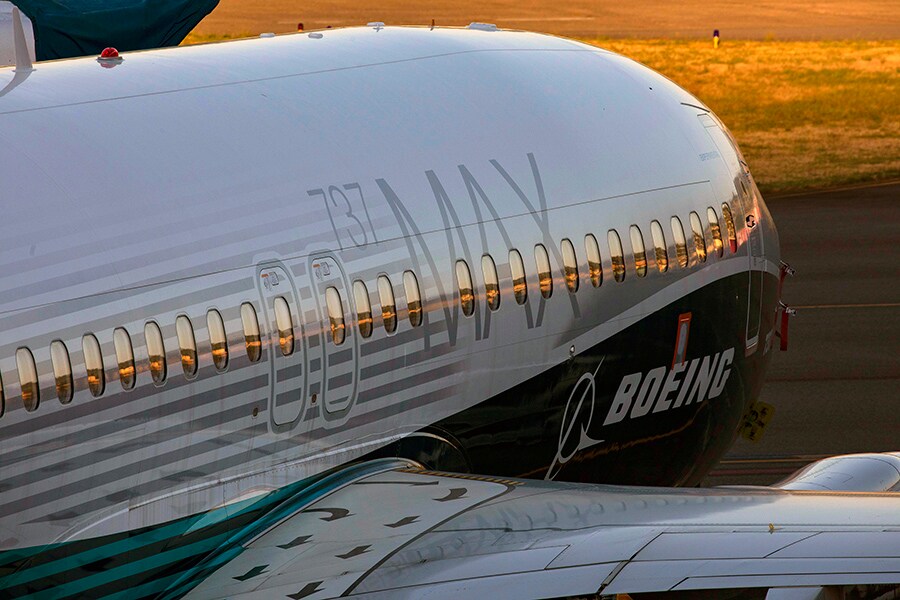Boeing employees mocked FAA and 'clowns' who designed 737 Max
"Would you put your family on a Max simulator trained aircraft? I wouldn't," one employee said to a colleague in an internal exchange


 A Boeing 737 Max airplane at the Renton Municipal Airport near Boeing"s factory in Renton, Wash., July 21, 2019. (Anna Moneymaker/The New York Times)(Ruth Fremson/The New York Times)[br]Boeing sent Congress more than 100 pages of documents Thursday that included internal communications between company employees mocking the Federal Aviation Administration and bragging about getting the regulator to approve the 737 Max with little new training required for pilots.
A Boeing 737 Max airplane at the Renton Municipal Airport near Boeing"s factory in Renton, Wash., July 21, 2019. (Anna Moneymaker/The New York Times)(Ruth Fremson/The New York Times)[br]Boeing sent Congress more than 100 pages of documents Thursday that included internal communications between company employees mocking the Federal Aviation Administration and bragging about getting the regulator to approve the 737 Max with little new training required for pilots.
The most damaging messages included conversations among Boeing pilots and other employees about software issues and other problems with flight simulators for the Max, a plane later involved in two accidents that killed 346 people and threw the company into chaos. The employees appear to discuss instances in which the company concealed such problems from the FAA during the regulator’s certification of the simulators.
“I still haven’t been forgiven by God for the covering up I did last year,” one of the employees says in messages from 2018, apparently in reference to interactions with the regulator.
“Would you put your family on a Max simulator trained aircraft? I wouldn’t,” one employee said to a colleague in another exchange. “No,” the colleague responded.
The messages and their disparaging tone threaten to further complicate Boeing’s tense relationship with the FAA and other regulators as a reputational crisis that has consumed the aerospace giant drags on. Both Boeing and the FAA indicated that the messages released Thursday did not raise new safety concerns, but they echo troubling internal communication among Boeing employees that was previously made public.
The release of the emails and instant messages is the latest embarrassing episode for Boeing in a crisis that has cost the company billions of dollars and wreaked havoc on airlines across the globe. The Max has been grounded for nearly 10 months, following the two deadly crashes. A software system developed for the plane was found to have played a role in both accidents, and since then the company has been working to update the system. There is still no indication when the Max might be cleared to fly again, as the company and regulators continue to discover new potential flaws with the plane.
Several lawmakers expressed dismay at the language used in the messages, saying they reflected a disregard for safety and broader problems with the culture at the company.
Rep. Peter DeFazio, D-Ore., who is leading the House investigation into the development of the 737 Max, called the emails “incredibly damning” in a statement. He added: “They paint a deeply disturbing picture of the lengths Boeing was apparently willing to go to in order to evade scrutiny from regulators, flight crews and the flying public, even as its own employees were sounding alarms internally.”
Sen. Richard Blumenthal, D-Conn., said in an interview that he would push for new congressional hearings to question Boeing leadership about the “astonishing and appalling” messages.
Boeing expressed regret. “These communications contain provocative language, and, in certain instances, raise questions about Boeing’s interactions with the FAA in connection with the simulator qualification process,” the company said in a statement to Congress. “Having carefully reviewed the issue, we are confident that all of Boeing’s Max simulators are functioning effectively.”
“We regret the content of these communications, and apologize to the FAA, Congress, our airline customers and to the flying public for them,” Boeing added. “The language used in these communications, and some of the sentiments they express, are inconsistent with Boeing values, and the company is taking appropriate action in response. This will ultimately include disciplinary or other personnel action, once the necessary reviews are completed.”
Boeing said that it notified the FAA about the documents in December and that it had “not found any instances of misrepresentations to the FAA with its simulator qualification activities,” despite the employee’s comment about “covering up” issues with the simulator.
Lynn Lunsford, a spokesman for the FAA, said in a statement that the messages did not reveal any new safety risks.
“Upon reviewing the records for the specific simulator mentioned in the documents, the agency determined that piece of equipment has been evaluated and qualified three times in the last six months,” Lunsford said. “Any potential safety deficiencies identified in the documents have been addressed.”
Lunsford added that, “while the tone and content of some of the language contained in the documents is disappointing, the FAA remains focused on following a thorough process for returning the Boeing 737 Max to passenger service.”
The tense relationship between Boeing and the FAA has been a complicating factor for the company as it works to persuade international regulators that the Max is ready to fly. Last month, Boeing fired its chief executive, Dennis A. Muilenburg, whose optimistic projections about the plane’s return to service created a rift with the regulator.
Stephen Dickson, the new chief of the FAA, has struck a more assertive tone in public comments about the Max, urging his employees to ignore outside pressure to quickly lift the plane’s grounding and telling Boeing that there is no set timetable for the Max to return.
In a meeting with Muilenburg last month, Dickson told the company not to make any requests of the regulator and to instead focus on completing the paperwork necessary for regulators to evaluate the update.
The Max is the latest update to Boeing’s 737, which has been flying since the 1960s. By making the plane similar to the 737’s existing NG model, Boeing was able to persuade regulators that pilots did not need to train on simulators. It was a particular selling point for Boeing, which faced significant competitive pressure from its chief European rival, Airbus.
Requiring simulator training can be costly for airlines and even after the crashes, Boeing told the FAA it was not necessary. It was not until Tuesday that Boeing said it would recommend simulator training for pilots who fly the Max.
Last year, Boeing disclosed internal messages from 2016, in which a top pilot working on the plane told a colleague that he was experiencing trouble controlling the Max in a flight simulator and believed that he had misled the FAA.
“I basically lied to the regulators (unknowingly),” said one of the pilots, Mark Forkner, to his colleague Patrik Gustavsson.
Boeing did not inform the FAA about the messages when the company first discovered them, waiting until about two weeks before Muilenburg was set to testify in front of Congress to send them to lawmakers. The conversation, which took place before the Max was approved to fly, angered key FAA officials, who felt misled by the company, according to three people familiar with the matter.
After the congressional hearings, Boeing moved Gustavsson out of his role working on the certification of new planes.
First Published: Jan 11, 2020, 07:49
Subscribe Now